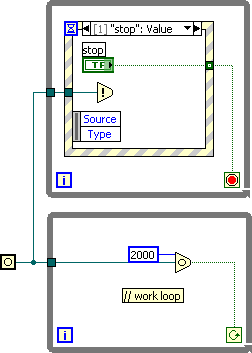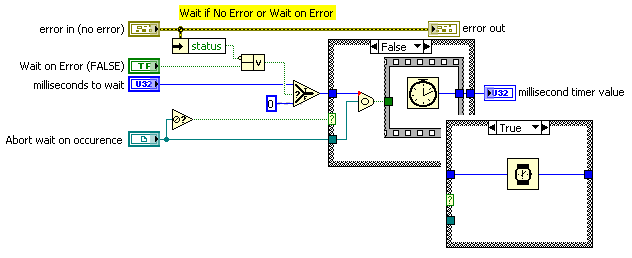
LAVA 1.0 Content
-
Posts
2,739 -
Joined
-
Last visited
-
Days Won
1
Content Type
Profiles
Forums
Downloads
Gallery
Posts posted by LAVA 1.0 Content
-
-
Hi,
I had some free time and just edited your vi (without considering any of the style) and messed it up a little more but i think it will work as intended...
Do not use this VI unless and until u clean it up properly.
-
QUOTE (jdunham @ Apr 29 2009, 08:58 AM)
Quick example with mouse over text color change.
http://lavag.org/old_files/post-3370-1241026080.vi'>Download File:post-3370-1241026080.vi
-
FOr the .x, you should change the formatting of the scale to %d.
You can change the position of the minimum and maximum by clicking on the outside of the maximum of the scale.
To rotate the scale click on the outside of the minimum.
To change the size of the needle, I think you have to copy the needle to word, edit the size and copy it back.
But I am not sure, I would check this on a dummy control.
Ton
-
-
Off course there is the 'Mouse Down' event.
Ton
-
QUOTE (xShadowDanx @ Apr 29 2009, 03:11 AM)
Somehow I couldn't download the file, could you upload it to LAVA directly?
Ton
-
-
All of the comparison primitives can operate on arrays.
The numeric to boolean array primitive makes a bitwise change from numeric to boolean.
However in most languages (and LabVIEW alike) a boolean false is a u8 with value 0.
To convert such an array to a boolean array use the <>0 primitive:

Ton
-
I have two ideas:
- Make some data dependency between the tasks, starting the output tasks after you have started the clock task.
- Let the analog output task generate the clock, and let the analog clock be used for the the digital output.
Set the start trigger of the digital task to be the analog start. Then first start the digital task and then start the analog task.
Ton
- Make some data dependency between the tasks, starting the output tasks after you have started the clock task.
-
I would try to set the 'Append to file' to true.
What is the value that you measured on the graph?
Currently the value is 25 m.
One advice, I wouldn't use a spreadsheet string format, especially because you loose precision and the decimal sign might change.
Ton
-
One additional warning, don't store settings in the LabVIEW temp folder, on my computer this one gets flushed every reboot.
Ton
-
Why don't you download the file with a temporary filename and then delete the original and rename the temporary file?
This is how firefox handles these kind of stuff, they just add a .part to the filename.
Ton
-
QUOTE (Black Pearl @ Apr 14 2009, 09:16 AM)
... But could not any one with a SVN client (given that the server is open to them) check out all files, or is the repository password protected?It is good to define access here. I think you mean a physical access via TCP/IP.
You can close a SVN repository for any kind of anonymous access, or make the anonymous (or unknown) clients read-only.
Clients/Users can be password protected
Ton
-
XControls behave almost like normal controls, you have properties, methods. One of the things missing are custom events.
What I mean is a way to trigger a specific event for a specific XControl instance for which an owning VI can register in a normal event structure without adding special code to that VI beside the Event case.
This technique would be awesome, especially in alarm XControls. You can see how such events work for Graphs where there are special events for Scales et al.
Any thoughts?
Ton
-
Or you could add an undocumented feature/backdoor, where a special key-combo openend the BD.
Ton
-
Attached are my low level LabVIEW VIs for HTTP GET and HTTP POST.
-
QUOTE (normandinf @ Apr 9 2009, 09:06 PM)
It would be C only after four iterations. It's B in the general case where you get to stop the loop before the fourth iteration.After four iterations, running average is the same as average of the last four measurements.
B states that it is the average of ALL measurements, which is incorrect, since it will only be the average of the last four measurements.
An average of all measurements is a weighted running average which is different than this example.
During the first three iterations of the loop it will be a weighted average of the initial measurement and the next i+1 measurements.
-
QUOTE (menghuihantang @ Apr 9 2009, 08:39 PM)
See the attached pic. A lot of people agreed that correct answer is B.I am so confused. How is it possible B is correct?? I think is C.
Whoever thinks B is the one, can you explain a little to me. Thanks.
I'm not sure who a lot of people are, but C is correct.
-
QUOTE (Jolt @ Apr 9 2009, 12:54 PM)
Specifically, I have an instrument that published a "website" with feedback information. I would like to be able to read this from a cRIO. This is very straightforward in Windows with examples such as "weather" using ActiveX and "atomic clock" using DataSocket.Unfortunately it seems that when deployed on a RT target, DataSocket does not support HTTP.
The http://forums.lavag.org/Posting-to-Twitter-from-LabVIEW-t13024.html&pid=57632' target="_blank">Twitter status VI I posted a while back is based on one of these.
-
Another trick might be, to get the image of the control with a bit depth of 1 resulting in a black/white image.
Ton
-
QUOTE (bsvingen @ Apr 9 2009, 07:21 AM)
... but a certified aircraft has abselutely no experimental features on board, everything has to be certified by international and local regulations. Certification is a lengthy process and is mostly about documenting every little aspect of every litlle bit.Our company works in the Railroad certification and for new 'experimental' stuff you mention we give a 'Verklaring geen bezwaar' (Declaration of OK) that allows us (or other) to place non-regulated systems during normal operation. Such declaration is very strict and the people handing out those certificates check and test everything beforehand. I don't recall any mallfunctioning based on such placed system.
I think the same might go for other transportation systems.
Ton
-
Isn't there a 'Autoscale once' property/method?
Yes there is.
QUOTE
Short Name: ScaleFitInstalled With: Base Package
Class: GraphScale Properties
Fit scale to data: 0-Do not autoscale, 1-Autoscale once now, 2-Autoscale.
This property applies only to the active X-scale or active Y-scale.
This property is similar to the AutoScale items on the shortcut menu of an x- or y-scale.
This property is similar to the Autoscale checkbox on the Scales page of the Properties dialog box.
Ton
-
Few pointers before getting to the point:
- Host you image at LAVA, this way the Portal won't be screwed up by your image size.
- Use the Code Capture Tool to create High-quality code images
Now on topic, have a look at the Array palette and try to delete column number 1 and 2.
Ton
- Host you image at LAVA, this way the Portal won't be screwed up by your image size.
-
QUOTE (Shaun Hayward @ Apr 8 2009, 07:21 PM)
QUOTE (jdunham @ Apr 8 2009, 08:27 PM)
We coerce to and from enums all the time, and it works fine -- IF your enum and the integer have the same numeric size (# bits). Of course enums default to 16-bit and integers default to 32 bit so you almost always have to fix one. YThe fact that this happens is because Typecasting is not a conversion tool! It only tells LabVIEW to look at the data at memory Address X as type Y instead of type Z.
The fact that it returns the first element of the Enum is expected if you use a U32 as source type for an U16 enum. The first two bytes of the U32 will be used as enum-value, and unless you have a single bit in the upper 2 bytes (>2^16) this will be 0.
Ton


.png)

Need Help Convert Ver 8.6 .Vi to Ver 7.1
in LabVIEW General
Posted
The best thing to do would be to send this Vi to your local NI office and ask them to down convert to what ever version you would like to